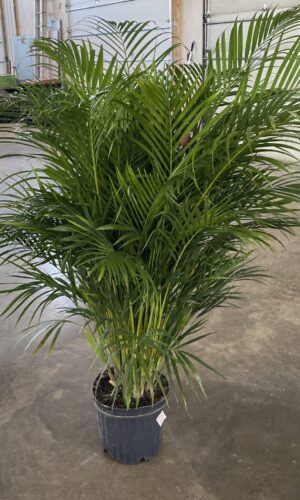The Areca palm, native to Madagascar, is one of the most popular indoor houseplants sold today. Indoors an Areca palm is a medium sized exotic looking plant that can reach a height of 6-8 feet; outdoors it may be as tall as 25 feet.
Areca palms require bright indirect light. Too much light or direct sun burns the fronds and causes them to yellow.
Keep the soil of an Areca palm moist but never soggy. Allow the top couple of inches to dry out before watering. Remember, the soil at the bottom of the container is much wetter than the soil at the top. Never allow an Areca palm to sit in water. If your household water has a lot of chemicals in it or passes through a water softener, allow it to sit out over- night before using it or use distilled water. Water containing a great deal of chemicals or salt can spot the leaves.
Areca Palms prefer temperatures between 65°-75° during the day and around 55° at night. This plant is very sensitive to low temperatures; if you place it outside during the summer be sure to bring it in before temperatures dip below 50°.
High humidity is essential for the fronds of an Areca palm to keep looking good.
Spider mites, this sucking plant pest causes yellow blotchy leaves with a red haze and a gritty feel to them. and Mealy Bugs can be a problem. Check frequently for pests by examining the backs of the fronds and new growth. If an Areca palm becomes infected, spray with warm soapy water or an insecticidal soap at 1/2 the recommended strength. Spraying with a product containing alcohol can damage the fronds.
Because Areca palms require high humidity, they are susceptible to the fungus Pink Rot and Ganoderma. Pink rot develops in moist soil and causes the fronds in the crown (top) of the palm to turn brown and droop. Ganoderma, which is spread through the soil and on pruning tools, causes the lower fronds to droop and turn yellow, then gradually works its way up the plant. Neither of these diseases is treatable but both are preventable by keeping the soil drier and providing good air circulation around the plant.
Use a rich acidic soil that drains well. Add builder’s sand if the soil is too heavy and clay like.
Plant an Areca palm in a container twice the size of the root ball. Palms like being a little root -bound, so don’t rush to repot.
Prune any brown or yellow fronds that appear. Use a wet scissors to prune brown tips on the fronds. Areca palms have only ne growing tip at the very top of the plant; if that tip is damaged or cut off, the plant stops growing.
A study by Wolverton has shown that an Areca palm is effective in removing benzene, formaldehyde and trichloroethylene from the air.

